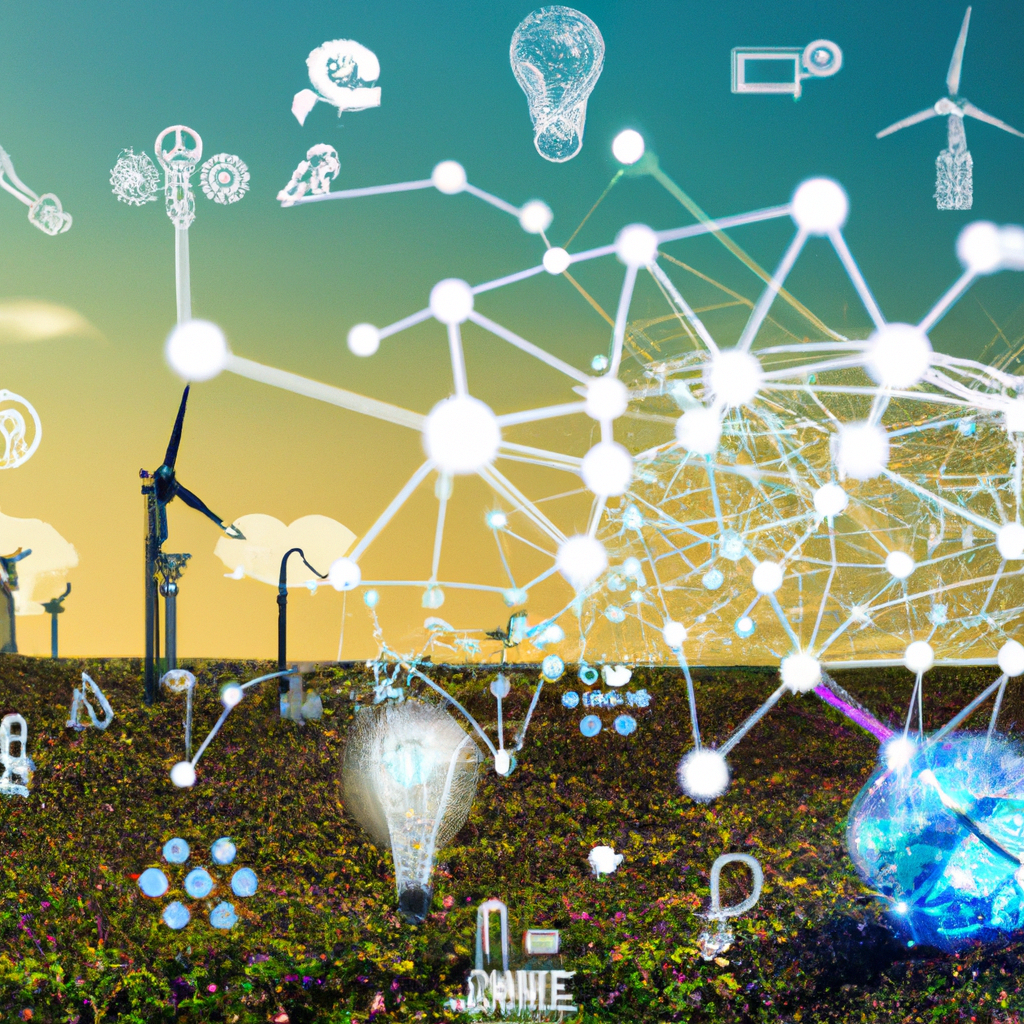-
Table of Contents
- Introduction
- Exploring the Potential of AI-Driven Energy Efficiency Solutions
- Harnessing AI to Create Smarter, More Sustainable Energy Sources
- The Impact of AI on Renewable Energy Production and Distribution
- How AI is Transforming the Energy Industry and its Regulatory Framework
- The Role of AI in Developing Smart Grid Technologies for the Future of Energy
- Conclusion
of AI and Energy: Unlocking a Brighter Future.
Introduction
The use of Artificial Intelligence (AI) in the energy sector is rapidly growing, with the potential to revolutionize the way energy is produced, distributed, and consumed. AI can be used to optimize energy production, reduce energy costs, and improve energy efficiency. AI can also be used to develop new energy sources, such as renewable energy, and to improve the reliability and security of energy systems. AI is also being used to develop smart grids and to enable the integration of distributed energy resources. This article will explore the advancements and opportunities in the field of AI and energy, and how AI can be used to create a more sustainable energy future.
Exploring the Potential of AI-Driven Energy Efficiency Solutions
As the world continues to grapple with the effects of climate change, energy efficiency solutions are becoming increasingly important. Fortunately, artificial intelligence (AI) is providing us with new and innovative ways to reduce energy consumption and improve efficiency.
AI-driven energy efficiency solutions are revolutionizing the way we use energy. By leveraging machine learning algorithms, AI can identify patterns in energy usage and suggest ways to reduce consumption. AI can also be used to automate energy-saving tasks, such as scheduling energy-efficient appliances to run during off-peak hours.
AI-driven energy efficiency solutions can also help us better understand our energy usage. By analyzing data from smart meters, AI can provide insights into how energy is being used in a home or business. This data can be used to identify areas where energy is being wasted and suggest ways to reduce consumption.
AI-driven energy efficiency solutions can also be used to optimize energy production. By analyzing data from renewable energy sources, AI can help identify the most efficient ways to generate energy. This can help reduce the cost of energy production and make renewable energy sources more viable.
The potential of AI-driven energy efficiency solutions is immense. By leveraging the power of AI, we can reduce energy consumption, optimize energy production, and gain valuable insights into our energy usage. With the right tools and strategies, AI can help us create a more sustainable future.
Harnessing AI to Create Smarter, More Sustainable Energy Sources
The world is facing an energy crisis. As the global population continues to grow, so does the demand for energy. To meet this demand, we must find smarter, more sustainable energy sources. Fortunately, artificial intelligence (AI) is helping us do just that.
AI is revolutionizing the energy industry. By leveraging data and machine learning algorithms, AI can help us identify and develop new sources of energy. AI can also help us optimize existing energy sources, making them more efficient and cost-effective.
For example, AI can be used to analyze data from wind turbines and solar panels to identify patterns and trends. This data can then be used to optimize the performance of these energy sources. AI can also be used to predict energy demand and adjust energy production accordingly.
AI can also help us reduce energy waste. By analyzing data from energy grids, AI can identify areas of inefficiency and suggest ways to reduce energy consumption. AI can also be used to detect and prevent energy theft.
AI is also helping us develop new sources of energy. AI can be used to identify potential sites for renewable energy sources, such as wind farms and solar farms. AI can also be used to develop new technologies, such as advanced batteries and fuel cells.
Finally, AI can help us reduce our carbon footprint. By analyzing data from energy grids, AI can identify areas where energy production is causing environmental damage. AI can then suggest ways to reduce emissions and improve energy efficiency.
AI is helping us create smarter, more sustainable energy sources. By leveraging data and machine learning algorithms, AI can help us optimize existing energy sources, reduce energy waste, develop new sources of energy, and reduce our carbon footprint. With AI, we can create a brighter, more sustainable future.
The Impact of AI on Renewable Energy Production and Distribution
The impact of artificial intelligence (AI) on renewable energy production and distribution is undeniable. AI is revolutionizing the way we produce and distribute renewable energy, making it more efficient and cost-effective.
AI is being used to optimize the production of renewable energy. AI-powered algorithms can analyze data from various sources, such as weather forecasts, to predict the most efficient times to produce energy. This helps to maximize the output of renewable energy sources, such as solar and wind. AI can also be used to optimize the distribution of renewable energy. AI-powered algorithms can analyze data from various sources, such as energy consumption patterns, to determine the most efficient way to distribute energy. This helps to ensure that renewable energy is distributed in the most efficient way possible.
AI is also being used to improve the safety and reliability of renewable energy production and distribution. AI-powered algorithms can analyze data from various sources, such as sensor readings, to detect potential problems before they occur. This helps to ensure that renewable energy production and distribution are safe and reliable.
Finally, AI is being used to reduce the cost of renewable energy production and distribution. AI-powered algorithms can analyze data from various sources, such as energy prices, to determine the most cost-effective way to produce and distribute energy. This helps to reduce the cost of renewable energy production and distribution, making it more affordable for consumers.
In conclusion, the impact of AI on renewable energy production and distribution is undeniable. AI is revolutionizing the way we produce and distribute renewable energy, making it more efficient, safe, reliable, and cost-effective.
How AI is Transforming the Energy Industry and its Regulatory Framework
The energy industry is undergoing a major transformation due to the emergence of artificial intelligence (AI). AI is revolutionizing the way energy is produced, distributed, and consumed, and is also changing the regulatory framework of the industry.
AI is being used to optimize energy production and distribution. AI-powered algorithms can analyze data from energy sources such as solar, wind, and hydroelectric power to determine the most efficient way to generate and distribute energy. This helps to reduce energy costs and increase efficiency. AI is also being used to monitor energy consumption and detect anomalies in energy usage. This helps to identify areas where energy can be saved and reduce energy waste.
AI is also being used to improve the safety and reliability of energy systems. AI-powered algorithms can detect potential problems in energy systems before they become serious, allowing for quick and effective repairs. This helps to reduce the risk of power outages and other disruptions.
Finally, AI is being used to improve the regulatory framework of the energy industry. AI-powered algorithms can analyze data from energy sources and energy consumption to identify areas where regulations need to be updated or improved. This helps to ensure that the energy industry is operating in a safe and efficient manner.
AI is transforming the energy industry in many ways, and its impact on the regulatory framework of the industry is just beginning to be seen. As AI continues to develop, it will continue to revolutionize the way energy is produced, distributed, and consumed, and will continue to shape the regulatory framework of the industry.
The Role of AI in Developing Smart Grid Technologies for the Future of Energy
The future of energy is bright, and Artificial Intelligence (AI) is playing a major role in developing smart grid technologies that will help us get there. Smart grids are the backbone of a modern energy system, and they are becoming increasingly important as we move towards a more sustainable and efficient energy future.
Smart grids use AI to monitor and control energy usage, allowing for more efficient energy distribution and consumption. AI can be used to detect and predict energy demand, allowing for better energy management and more efficient use of resources. AI can also be used to detect and prevent energy theft, as well as to identify and respond to potential energy outages.
AI can also be used to optimize energy production and distribution. AI can be used to identify and respond to changes in energy demand, allowing for more efficient energy production and distribution. AI can also be used to identify and respond to changes in energy prices, allowing for more efficient energy pricing.
AI can also be used to improve the security of the energy grid. AI can be used to detect and respond to cyber-attacks, as well as to identify and respond to potential threats to the energy grid. AI can also be used to detect and respond to changes in energy usage patterns, allowing for more efficient energy management.
AI can also be used to improve the efficiency of energy storage. AI can be used to identify and respond to changes in energy storage needs, allowing for more efficient energy storage. AI can also be used to identify and respond to changes in energy storage costs, allowing for more efficient energy storage.
AI is playing an increasingly important role in developing smart grid technologies for the future of energy. AI can be used to monitor and control energy usage, optimize energy production and distribution, improve the security of the energy grid, and improve the efficiency of energy storage. AI is helping to make the energy future brighter and more sustainable.
Conclusion
In conclusion, AI and energy are two fields that are rapidly advancing and providing new opportunities for innovation. AI is being used to improve energy efficiency, reduce energy costs, and increase the reliability of energy systems. AI is also being used to develop new energy sources and to optimize energy production and distribution. AI is also being used to develop new energy storage technologies and to improve the safety and security of energy systems. AI is providing new opportunities for energy companies to increase their efficiency and reduce their costs. AI is also providing new opportunities for individuals and businesses to reduce their energy consumption and to increase their energy efficiency. AI is an exciting field that is providing new opportunities for energy companies, individuals, and businesses to reduce their energy costs and increase their energy efficiency.





